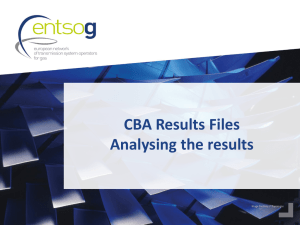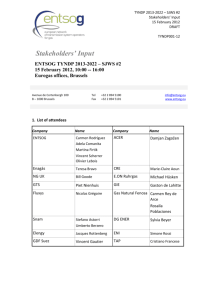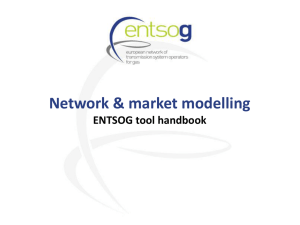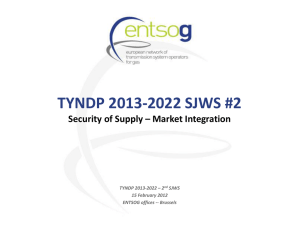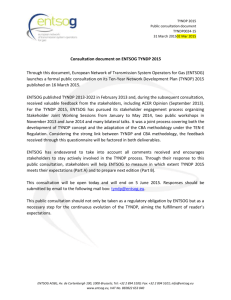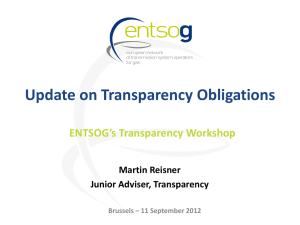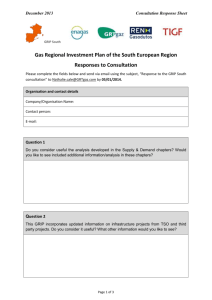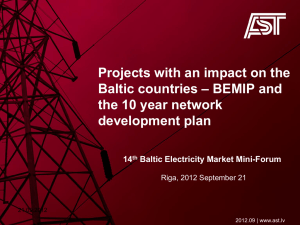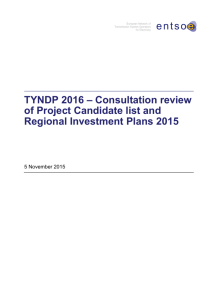ENTSOG TYNDP 2013-2022 Consultation document
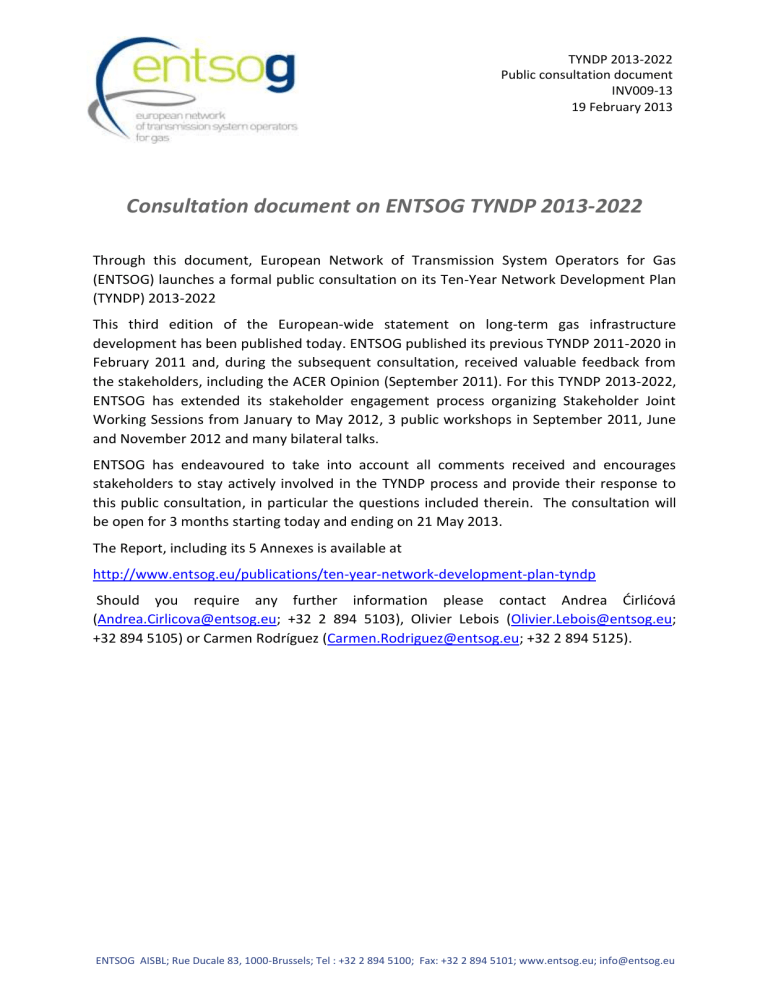
TYNDP 2013-2022
Public consultation document
INV009-13
19 February 2013
Consultation document on ENTSOG TYNDP 2013-2022
Through this document, European Network of Transmission System Operators for Gas
(ENTSOG) launches a formal public consultation on its Ten-Year Network Development Plan
(TYNDP) 2013-2022
This third edition of the European-wide statement on long-term gas infrastructure development has been published today. ENTSOG published its previous TYNDP 2011-2020 in
February 2011 and, during the subsequent consultation, received valuable feedback from the stakeholders, including the ACER Opinion (September 2011). For this TYNDP 2013-2022,
ENTSOG has extended its stakeholder engagement process organizing Stakeholder Joint
Working Sessions from January to May 2012, 3 public workshops in September 2011, June and November 2012 and many bilateral talks.
ENTSOG has endeavoured to take into account all comments received and encourages stakeholders to stay actively involved in the TYNDP process and provide their response to this public consultation, in particular the questions included therein. The consultation will be open for 3 months starting today and ending on 21 May 2013.
The Report, including its 5 Annexes is available at http://www.entsog.eu/publications/ten-year-network-development-plan-tyndp
Should you require any further information please contact Andrea Ćirlićová
( Andrea.Cirlicova@entsog.eu
; +32 2 894 5103), Olivier Lebois ( Olivier.Lebois@entsog.eu
;
+32 894 5105) or Carmen Rodríguez ( Carmen.Rodriguez@entsog.eu
; +32 2 894 5125).
ENTSOG AISBL; Rue Ducale 83, 1000-Brussels; Tel : +32 2 894 5100; Fax: +32 2 894 5101; www.entsog.eu; info@entsog.eu
TYNDP 2013-2022
Public consultation document
1.
Infrastructure
1.1.
Collection process
In order to ensure a consistent, transparent and non-discriminatory collection process of infrastructure projects, ENTSOG launched a public Call for project information during
Summer 2012. Information collected through this process has been used to provide an overview of potential infrastructure development for the next 10-year and, in particular, as input for the network modelling. Detailed infrastructure project profiles are included in the
TYNDP 2013-2022 Annex A.
> Q 1: Could you suggest any further ways to enhance the Call for project information process?
> Q 2: If you are a project promoter that participated in the data collection process, how did you find the on-line application used for that purpose? Do you have concrete proposals on how to improve this process further?
1.2.
Collected data
Collection of data has been quite challenging for ENTSOG in terms of the amount of data to be collected and the willingness of project promoters to submit data.
> Q 3: As project promoters found it difficult to fill in the “project phase” part of the questionnaire, what changes should be made (which steps and associated definition) to cover all relevant parts of a project development? Please list maximum 4 project phases.
> Q 4: Do you think that ENTSOG should or should not include projects in the TYNDP where not all mandatory information (i.e. information necessary for network modelling) has been submitted?
1.3.
Criteria and clustering
In order to build different infrastructure clusters to better assess the possible evolution of the European gas network, ENTSOG has chosen to aggregate projects according to their FID status (Final Investment Decision taken/ not taken). It is seen by ENTSOG and by many stakeholders as the only transparent, pragmatic and non-discriminatory parameter. It is noted that projects of a cluster are considered simultaneously for network modelling purposes and hence the choice of the parameter has a significant impact on the results of any given case.
> Q 5: Do you see any other relevant criteria? If yes, which ones?
2.
Network model
ENTSOG’s modelling approach has been based on market Zones linked by entry-exit capacity in line with the framework established for access to capacity by Regulation (EC) 715/2009.
Page 2 of 7
TYNDP 2013-2022
Public consultation document
To consider the underlying physical infrastructure correctly, this approach has nevertheless been further refined to include a specific Zone for an independent infrastructure within a country and specific representation of long-haul pipelines.
> Q 6: Which further improvements regarding the network topology would you consider useful, if any?
Based on feedback received on the TYNDP 2011-2020 approach (equal load factor) to allocating supply from a given supply source to an import route, ENTSOG has considered a load-factor derived from the average load factor observed during the last 3 years. .
> Q 7: Do you consider it as an appropriate methodology? If not what alternative approach would you advocate?
Considering that not every theoretical Situation could be run (TYNDP 2013-2022 is based on more than 200 situations compared to the 67 of the previous edition), what should be the priority for an even more robust assessment:
> Q 8: Running some scenario-based assessments on demand? If yes, which types?
> Q 9: Considering additional Supply Stress Situations under Infrastructure Resilience? If yes, which ones?
> Q 10: ENTSOG has run 4 different infrastructure assessments in the TYNDP. Do you consider these to cover all essential aspects of the European gas system or would you recommend applying any alternative analysis?
> Q 11: All flow patterns used by ENTSOG in its TYNDP are considered technically feasible by TSOs, do you consider there is a need to define non-technical criteria in order to select only the most probable flow patterns? If yes, which criteria?
3.
Demand and Supply
3.1.
Demand
> Q 12: What is your opinion on ENTSOG’s approach to demand? Does a single demand scenario analysed through different daily situations cover a sufficiently wide range?
> Q 13: If not, what is the added value of multiple demand scenarios, and what parameters should be used?
> Q 14: Is the introduction of Uniform Risk Situation a valuable improvement? If yes, which added value does it bring for you?
> Q 15: Is the introduction of 14-day Situation a valuable improvement? If yes, which added value does it bring for you?
3.2.
Daily Demand Situations
In addition to the 1-day Design-Case Situation which ensures consistency with national plans and represents the benchmark for the transportable energy, the assessment also includes a
14-day Uniform Risk Situation to capture the temporal dimension using the same occurrence
Page 3 of 7
TYNDP 2013-2022
Public consultation document at country level.
> Q 16: As storage is analysed only through simulations of extreme situations (high daily demand), do you consider that other situations should be covered in order to assess the role of storage under less stressful conditions? If yes, please specify.
> Q 17: Considering the interaction between gas and electricity, should the consistency between gas and electricity scenarios be based on installed capacities (indirectly linked to the peak utilisation of the infrastructure in case of their concurrent use) or forecasted utilisation factors?
3.3.
Supply
Under Average Day, supply shares for the Reference Case Situations are based on the historical data of 2009, 2010 and 2011, and then increased according to the Net Demand
(National Demand minus National Production) growth. In order to assess both capacity and supply availability, a defined supply potential was used for each source as a supply cap.
ENTSOG has introduced three Potential Supply scenarios for each supply source in order to capture supply uncertainty. The Intermediate Potential Scenarios have been used as a supply cap for the Reference Case Situations.
> Q 18: Do you agree on the way to define supply shares under the Reference Case?
> Q 19: Do you consider the introduction of the three Potential Supply scenarios as beneficial?
> Q 20: What is your opinion on the level of each of the 3 Potential Supply scenarios
(Minimum, Intermediate and Maximum) for each source (Azerbaijan, Algeria, Libya, LNG,
Norway and Russia)? In case you consider them inadequate, please specify why and which sources of information should be used for an enhanced definition.
> Q 21: Regarding the definition of LNG supply scenarios, the Minimum and Intermediate scenarios have been defined on the basis of the historical load factors of European LNG terminals, while the Maximum was defined according to the evolution of liquefaction capacities by basin and the historical shares of the production of each basin exported to the EU. Is this approach adequate? If not, what other parameters are missing?
> Q 22: Considering that supply is out of TSOs’ remit and that stakeholders have not provided any detailed information on the topic during SJWSs, in which direction, do you think, could the supply analysis be investigated further?
3.4.
Supply allocation
Under high daily demand Situations, each import source has been set at the maximum reached between the years 2009 and 2011. This value has been increased only in case of a new project increasing the capacity of the import routes coming from that source. UGS and
LNG terminals (their storage component) are then used as sources of last resort supply. LNG storage component is based on the Average Day value increased by 10% to capture the seasonal swing.
Page 4 of 7
TYNDP 2013-2022
Public consultation document
> Q 23: Do you agree with the evolution of import based on historical values and its increase according to the import route capacity development?
> Q 24: Do you agree with the dual approach established for LNG (import and storage component)?
4.
Assessment Results
As an answer to stakeholders’ concerns that Security of Supply should not be seen as separated from market integration, and that TYNDP does not assess directly such integration, the links between the Energy policy pillars and market integration, and the assessment provided by the TYNDP have been reviewed and redefined.
> Q 25: Do you consider this new structure as more representative? If not, which modifications do you see as necessary?
4.1.
Infrastructure Resilience
For this third edition, ENTSOG considered the following Supply Stress events: technical disruptions (from Norway to France and the UK, and from North Africa to Italy and Spain), transit disruptions (Russian gas through Ukraine and Belarus), supply disruption (Azeri gas) and the low deliverability of LNG terminals.
> Q 26: Do you consider these events appropriate?
> Q 27: What other events should, in your opinion, be accounted for?
4.2.
Supply Source Dependency
This new approach aims at identifying Zones whose annual balance depends on at least 20% of a given source.
> Q 28: Do you value this addition?
> Q 29: Is the yearly analysis the right basis for this assessment?
4.3.
Adaptability to Supply Evolution
This new approach aims at identifying the ability of the European gas system to balance each Zone on annual basis when each source moves from the Reference Case share up to the Maximum Supply Potential or down to the Minimum Supply Potential.
> Q 30: Do you value this addition?
> Q 31: Is the yearly analysis the right basis for this assessment?
4.4.
Supply Source Diversification
ENTSOG has refined its approach to the assessment of the Supply Source Diversification by applying the Targeted Maximisation modelling approach. What is your view on the following parameters?
> Q 32: The use of non-simultaneous targeted flow patterns to test the maximum physical
Page 5 of 7
reach of each source?
> Q 33: The use of 5% and 20% as supply share thresholds?
TYNDP 2013-2022
Public consultation document
4.5.
Pilot indexes
As a way to collect stakeholders’ feedback on some indicators to be included in the Cost-
Benefit Analysis methodology to be developed by ENTSOG, two capacity-based indexes have been introduced.
> Q 34: Do you consider the Import Route Diversification Index as introducing the right approach for such analysis? Which further development would you consider valuable?
> Q 35: Do you consider the Import Dependency Index as introducing the right approach for such analysis? Which further development would you consider valuable?
5.
Barriers to investment and potential solutions
This new chapter has been introduced in consideration of the framework established for the
TYNDP by Regulation (EC) 715/2009. It identifies the different factors that can negatively impact the appetite for new infrastructure projects and the willingness of project promoters to take a Final Investment Decision. At the same time, it describes positive elements which could help the system in overcoming these opposing factors.
> Q 36: Do you share the same view regarding the identified barriers? If not, please explain. Which other factors would you like to be considered?
> Q 37: Do you see other ways to reduce barriers besides those proposed in the Report?
6.
Future role of the TYNDP in the PCI process
TYNDP 2013-2022 is released before the entry into force of the Infrastructure Guidelines
Regulation defining the PCI selection process. Nevertheless, the TYNDP already provides a definition of demand and supply Scenarios, a system-wide analysis of the European gas system and some indicators assessing the infrastructure-related market integration.
> Q 38: In that respect, do you consider TYNDP 2013-2022 methodology as a sound basis for the development of the future Energy System-Wide Cost Benefit Analysis (CBA)? If not, what should be further elaborated?
ENTSOG is planning to launch a public consultation on the CBA methodology Scoping document soon. This will provide stakeholders with further opportunity to comment on the future role of TYNDP in the PCI process.
7.
General questions
7.1.
Stakeholder engagement
Considering that stakeholders‘ involvement in the TYNDP process is crucial regarding the
Page 6 of 7
TYNDP 2013-2022
Public consultation document identification of their expectations and the collection of data beyond TSOs’ remit, are you satisfied with the dialogue between ENTSOG and stakeholders during the TYNDP process?
> Q 39: How could this process be further improved?
7.2.
Use of graphics
Graphical layout of quantitative information is a key element helping the reader to grasp complex information.
> Q 40: What is your opinion of graphical representation of information in the TYNDP
2013-2022 (Methodology, Supply and Demand, and Assessment Results chapters)?
> Q 41: Which further improvement would you suggest?
7.3.
Data accessibility
ENTSOG has taken special care to make all TYNDP-related data available in an easy way and in a format that allows for further analysis.
> Q 42: What is your opinion on the new format of Annex A and B? Do you have any proposals for further improvement?
> Q 43: Do you consider that hard copies of the TYNDP should be available upon request as a complementary option to the on-line download?
7.4.
Sustainability
ENTSOG has introduced some thoughts on the assessment of the role of gas and gas infrastructure for sustainability through the quantitative assessment of gas demand for power generation.
> Q 44: Which other way(s) would you consider adequate for capturing the role of gas infrastructure in a sustainable energy policy?
7.5.
Next focus
Considering the TYNDP as a continuous process facing a rapidly evolving market and expectations, which improvement do you value the most in comparison with the TYNDP
2011-2020?
> Q 45: Which improvement should be given priority for the next edition (maximum 3 ranked answers)?
Please feel free to address any other issues that may not be covered by the questions above but, in your opinion, deserves further elaboration?
Thank you in advance for your participation in this public consultation.
Page 7 of 7
